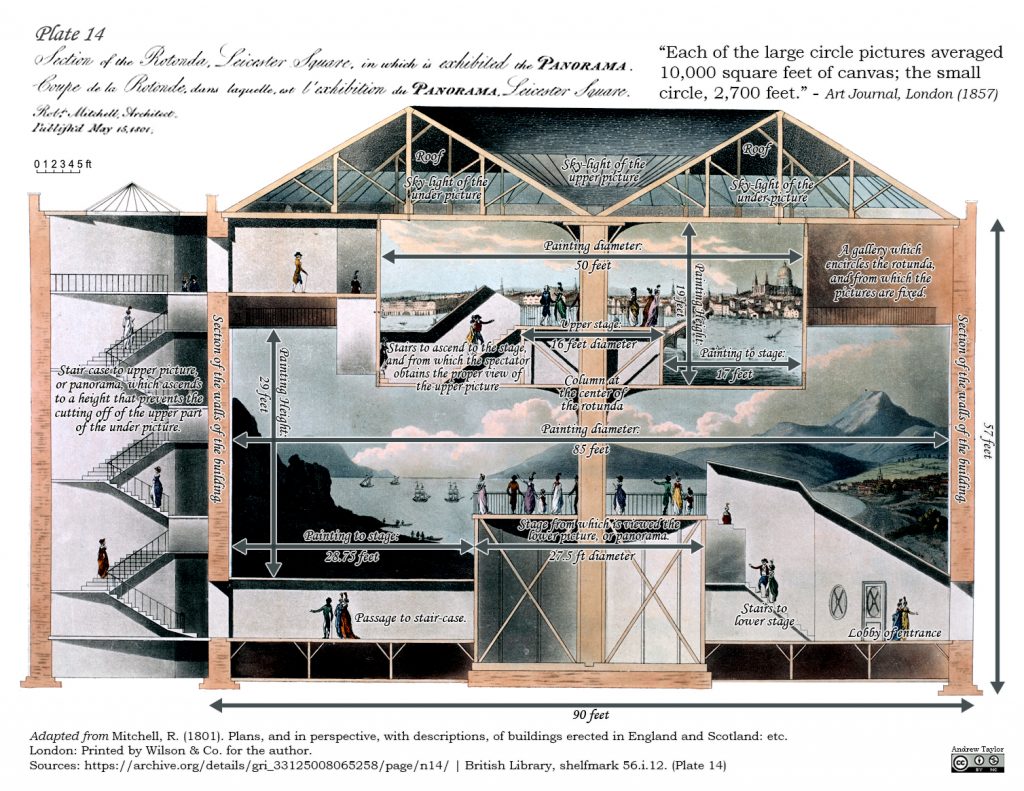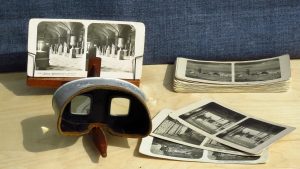3 A Brief History of VR
Introduction
If you look back through history and document reactions to newly emergent technologies, you will see a predictable pattern: there were some who saw the new invention for all its promising capabilities while others insisted that it posed extraordinary dangers.
Naysayers said that the first electrified subway system was an underground death trap. “People were not made to travel underground!” it was said. But then, when people finally rode on the subways, they found that it was actually quite a nice experience.
Motion picture films, in their first decades as an entertainment medium, were believed to cause juvenile delinquency and depraved behavior based on the imitative behavior theory. For example, in 1913, “After [a censor] banned some films of people dancing (the turkey trot and the tango), he said that ‘the objection is not based so much upon these pictures in themselves, but upon the effect they would have on thousands of young people.'” (Denby, 2016). Communities all over the country mandated censorship despite arguments about Free Speech. This practice dissolved through a combination of legal decisions and changes in social standards that were less paternalistic.
In the 1950s, comic books were targeted as a corrupting influence on young people. Piles of comic books were burned, fostered by the belief that “…Hitler was a beginner compared to the [influence of the] comic-book industry.” (Werther, F., 1954).
In this chapter, we examine the promise (and outrage) held in one of the newest media technologies to become accessible to the general public: Augmented, Virtual, and Mixed Realities (AR/VR/MR), collectively referred to as reality technologies.
The readings and media in this chapter touch upon the basic capabilities of reality technologies and then go beyond the “wow factors” to explore their potentially negative collateral effects and promising deliverables.
Key Terms
As a relatively new and evolving field of study, the terminologies used to describe AR/VR/MR are often changing. The following definitions provide basic descriptions, though there may be additional nuances to them under certain conditions.
360 Degree Video (360)– video which is viewable with a headset or other device in which the user can determine the angle of viewing but cannot interact with the scene beyond passive observation. Example: Journey to the Edge of Space
Augmented Reality (AR) – .”..taking digital or computer generated information, whether it be images, audio video and touch or haptic sensations and overlaying them [onto] … a real-time environment” (Kipper, G., 2012, p.18). Example: Pokemon Go
Virtual Reality (VR) – “A completely artificial digital environment that uses computer hardware and software to create the appearance of a real environment to the user” (Kipper, G., 2012, p. 22). Example: Beat Saber
Mixed Reality (MR) – .”..where real world objects or people are dynamically integrated into virtual worlds to produce new environments and visualisations where physical and digital objects co-exist and interact in real time” ( Retrieved 12-17-2017 from: http://www.realitytechnologies.com/mixed-reality ). Microsoft offers a more detailed illustration of MR with graphical and video representations of MR across the full spectrum of reality technologies. Example: Mario Kart Live: Home Circuit
Reality Technologies – A blanket statement used to describe all of the varieties of 360/AR/VR/MR.

Haptic Feedback – The experience of vibrations and other sensory experience associated with a VR experience. Examples of this are found in surgical training.
A Brief History of Virtual Reality
The idea of virtual reality is older than you might think. People seem to have a deep desire to create synthetic representations of different places, worlds or experiences. Te following is a brief, and by no means complete, tracing of the development of consumer-level tools for consuming and creating virtual reality.
The concept of virtual reality can be traced as far back as 1787 when English painter Robert Barker coined the term “panorama,” a term you’re probably familiar with, and opened his cyclorama. Barker painted giant landscapes which were displayed in cylindrical buildings through which viewers could walk and look out as if at a real-life scene. Other iterations of Barker’s concept involved paintings on large scale sheets which could be moved past stationary viewers as if they were travelling and looking out the window.


In 1838 the first stereoscope was invented which used two lenses and two nearly identical images which, when viewed, created a three dimensional projection. The technology eventually evolved into Mattel’s View Master which was patented in 1939. The concept of a slightly different image fed into each eye creating realistic perspective is still an important component of virtual reality viewers today.
In the 1890s we see the birth of cinema, opening the potential for the experience of moving images just as we experience them in the real world. Surprising as it may seem, when The Lumière Brothers first showed their recording Arrival of a Train at Le Ciotat (1895), people in the cinema jumped out of their seats and ran for the doors thinking a train was really barreling into the theatre. In that sense, early cinema really was early virtual reality.
https://youtube.com/watch?v=1dgLEDdFddk
The panorama and cinema became one for the first time when Raoul Grimoin-Sanson’s Cinéorama was revealed at the 1900 Paris Exposition. This exhibition simulated a hot air balloon ride by pointing ten synchronised projectors outwards from a central booth towards screens positioned around a circular room. The audience viewed the experience from above the booth as if they were seated in the basket of the hot air balloon. Due to the heat generated by the projectors and fears of fire, the Cinéorama never gained popularity.
In the 1950s Morton Heilig wrote of an “Experience Theatre” that could encompass all the senses. He built a prototype which he named the Sensorama in 1962 and created five short films which engaged multiple senses (sight, sound, smell, and touch). As the design predated digital computing, this was a mechanical device. Heilig also developed what he referred to as the “Telesphere Mask.” The patent application (1960) described it a vision apparatus which gives an individual spectator a complete sense of reality with colour images, scents and binaural sound. Heilig’s visionary creations were more in line with the stereoscope than other technologies as they focused on an individual experience of virtual reality rather than collective one.
In the 1950s and 60s Disney joined in the virtual revolution implementing it in their parks. They coined a new term for the technology calling it Circle Vision 360. A similar technique to that of the Cinéorama was employed with synchronised projectors pointing towards different angles of a room to create one cohesive immersive video experience.
By the 1980s, the term “virtual reality” had been popularised by Jaron Lanier, one of the modern pioneers of the field. Lanier founded the company VPL Research in 1985, which has developed a number of VR devices that integrate visuals with haptic and auditory experiences. VPL licensed the DataGlove technology to Mattel (the same toy company which owns View Master), which used it to make the Power Glove, an early affordable VR device.
2007 brought immersive 360 degree technology from cinema screens to computers with the launch of “street view” on Google Maps.
2013 saw the first consumer-level 360 degree camera, Bublcam, successfully funded by Kickstarter, bringing the power to create immersive experiences to hobbyists for the first time.
From 2010-on it became clear that gaming would be a huge market for virtual reality applications with development beginning on technologies including the Oculus Rift, HTV Vive and Playstation VR.
In 2015 Google launched Google Cardboard, a simple and inexpensive VR headset which only required a mobile phone to work. In the same year, 360 degree uploads were introduced to Facebook and YouTube, encouraging and enabling anyone to consume virtual reality content from their own homes.

